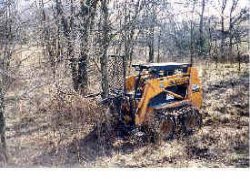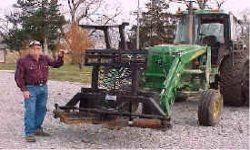

To send a message to an author, click on the author's name at the end of the article.
This Month in Ag Connection | Ag Connection - Other Issues Online
Bermudagrass is a warm-season grass native to southeast Africa. It is widely grown in the southeastern United States and has gained popularity in the southern part of Missouri. Producers are interested in bermudagrass in more northern areas of the state as a forage source for the warmer months of the grazing season during the months of June, July and August when the quality and quantity of cool-season grasses such as tall fescue and orchardgrass are poor.
While cold tolerance is important in selecting a bermudagrass variety for Missouri, consideration should also be given to yield potential, quality and palatability. Varieties available include Midland, Hardie, Guymon, Wrangler, Greenfield, Tifton 44, Midland 99, Quickstand and Worldfeeder. A more detailed description of each variety and its differentiating characteristics can be found in MU guide G4620: http://extension.missouri.edu/publications/DisplayPub.aspx?P=G4620
Bermudagrass establishment is accomplished with sprigs for most varieties. There are seeded varieties available but they currently appear to be less winter hardy, take longer to establish, and are not as productive. Sprigging rates are around 20 bushels per acre and can vary with the situation. Prices vary greatly by variety (from one dollar to twenty dollars per bushel). Make sure you know which variety you are pricing. Check the performance characteristics to select the variety - not just the price. Planting an inexpensive variety that does not produce or is killed by winter conditions is not economical.
Of the warm-season perennial grasses available, bermudagrass is one of the most suitable in a management-intensive grazing system. Bermudagrass is responsive to nitrogen and has the potential to provide a large quantity of high-quality forage throughout the summer if managed properly. Where it is adapted, bermudagrass is hardy enough to survive with little care but responds quickly to more intensive management. The most important considerations during establishment of bermudagrass are to prepare a clean seedbed, plant a winter-hardy cultivar and control weeds. Use only fresh, moist, healthy and weed-free sprigs that have been grown under a good fertility program. Sprigs should be kept moist but not wet, cool, and in the shade to ensure survival. As a rule of thumb, sprigs should be planted within 24 hours of digging.
Sprigged bermudagrass plots were established on June 7, 2002 at Lincoln, MO. The plots appeared thin in the fall of 2002 but were healthy. By spring, the plots had thickened. The first harvest occurred on June 12, 2003. Second harvest was on July 31, 2003. Both harvests were severely affected by the dry weather. Due to dry weather there were only two harvests. The data is an average of three replications. The data is adjusted to 20% moisture and expressed as tons per acre.
| June 7 | July 31 | Total | |
|---|---|---|---|
| (T/Acre) | (T/Acre) | (T/Acre) | |
| Midland | 0.79 | 1.04 | 1.83 |
| Ozarka | 1.49 | 1.00 | 2.49 |
| Hardie | 0/79 | 0.70 | 1.49 |
(Author: Wayne Crook, Agronomy Specialist)
This Month in Ag Connection Ag Connection - Other Issues Online

With the new year comes questions of reseeding or seeding pasture. Kentucky-31 has been around a long time and is known for its resistance to drought, disease, overgrazing and weed pressure. The endophyte that makes the fescue tough is also what sickens livestock. The cattle, sheep, horses and goats that graze it all suffer in varying degrees from the effects of the toxin produced by the endophyte.
Endophyte free fescues are on the market, but they lack the persistence of endophyte-infected varieties. In stressful environments, a thick stand can drop to nearly nothing. There are alternatives that are promising. These include two newly released turf species that contain "novel" endophytes, which protect the plants without harming the animals. Jesup/Max Q, from the University of Georgia uses an endophyte from New Zealand. ArkPlus, which comes from the University of Arkansas and a University of Missouri cultivar, uses an endophyte from the Mediterranean Sea region.
The question that is asked is "Should we plant novel endophytes?" According to Craig Roberts, University extension state forage specialist, "maybe." For grass dairy operations, the answer is usually yes according to Roberts. Dairy cows that graze toxic-endophyte fescue experience a 30% reduction in milk production.
The problem is nearly as bad in cow-calf operations. Calving rates in K-31 operations are about 55 to 60%, while cattle in endophyte-free pastures calve at a 95% rate. Each additional 10% of toxic endophyte in the fescue reduces daily weight gain by one-tenth of a pound and cuts calving rates by 5% according to Roberts. This is a serious matter. Fescue seed can be tested for the toxic endophyte levels and costs about $35. If the endophyte level in conventional fescue is 30% or below, a producer might consider keeping it. A level of 60% or higher will seriously affect animal performance according to Roberts.
Novel-endophyte is not a given. North of Interstate 70, Missouri producers can get away with endophyte-free fescue because of less serious heat-stress problems. This could vary year to year depending on weather patterns.
The cost of novel endophyte fescue seed is $3 to $4 a pound, about double the price of endophyte-free fescue seed. The novel endophyte fescue contains a patented endophyte and it is illegal to save seed from these varieties.
Novel endophytes are an investment. If you own the land and aren't near retirement, or your kids will farm that land, it is worth thinking about according to Roberts.
(Author: Wayne Crook, Agronomy Specialist)
| Yield (tons/acre) | |
|---|---|
| Mac | 2.63 |
| MaxQ | 2.52 |
| Bluegrass | 2.13 |
| Average | 2.43 |
This Month in Ag Connection | Ag Connection - Other Issues Online
Utilization of a brush and tree shear can remove and pile unwanted woody growth very quickly with a minimum effort, minimal disturbance of the soil, and at a relatively reasonable cost. Tree shear equipment can be attached to a skid-steer, tractor loader, or 3-point hitch. Some tree shears are designed with grapple options for holding the tree while it is being cut and then allows for easy movement and piling. Another option frequently added is a sprayer attachment that allows the stump to be treated following the tree being sheared.
Shear equipment for land clearing is made to handle tree diameters up to 20" with one bite. However, the size more commonly purchased for land clearing is in the 12" and 14" range. Cost of the units varies between manufacturers from $4,000 to $10,000 depending on the size and options. A landowner might want to consider touring some land that has been sheared and/or hiring someone with a shear unit to demonstrate this practice. Custom rates will vary with the type of equipment, but rates appear to be averaging $45 to $65 an hour.
 |
Pictured are a skid-steer and a tractor-mounted unit. Many of the manufacturers have web sites giving more information. |
 |
(Author: Parman Green, Ag Business Management Specialist)
This Month in Ag Connection Ag Connection - Other Issues Online
We are fast approaching the spring green up season and it is time to make plans for spring forage management. This article includes just a few reminders of management considerations in your forage operation. Complete details are available through the University Extension guide sheet series at your local extension office or can be found online at http://extension.missouri.edu/main/DisplayCategory.aspx?C=1#publications.
MU Guide 4652 " Seeding Rates, Dates and Depths for Common Missouri Forages" is an excellent resource on over 30 grass and legumes used in Missouri. It also includes recommended seeding rates for many combinations of grasses and legumes. MU Guide 4650 "Establishing Forages" discusses the use of companion crops, methods of seeding and many other management considerations.
Legume Checklist:
Grass Checklist:
(Author: Todd Lorenz, Horticulture/Agronomy Specialist)
This Month in Ag Connection | Ag Connection - Other Issues Online
Publishing Information
Ag Connection is published monthly for Northeast and Central areas of Missouri producers and is supported by the University of Missouri Extension, the Missouri Agricultural Experiment Station, and the MU College of Agriculture, Food and Natural Resources. Managing Editor: Mary Sobba.